
Composer Profile: Giuseppe Verdi, Italy’s Greatest Composer
By David SalazarGiuseppe Verdi is Italy’s composer.
Few composers have ever attained the legendary status of the man from Busetto, who created a plethora of operas throughout his career that remain fixtures of the standard repertoire today.
Born on Oct. 9 (or was it 10?), 1813, Verdi would become the textbook example of how to achieve everlasting greatness when you put in the work over the course of your life. He was an ardent student of his craft, working to perfect and develop it over his lengthy career. Verdi wasn’t quite the revolutionary that his contemporary Wagner was, but he did provide a bridge between the era of bel canto and that of verismo opera.
His operas range in style and scope, but there is a consistent artistic vision in Verdi’s oeuvre that can best be characterized by a preoccupation between the person’s role as an individual in a larger context. Verdi’s heroes and heroines are often placed in larger-than-life situations and forced to choose between moral duty and emotional desires. They are also quite often complex in their characterizations, giving the world of opera some of the most nuanced works. Moreover, Verdi’s operas are among the most melodic ever concocted, a major reason for his enduring popularity.
Verdi’s writing for the voice is so nuanced and complex that he even fathered a style of baritone voice that had never existed previous to his arrival on the operatic scene.
He created close to 30 operas over the course of his career, his first being “Oberto (1839)” and his final one being “Falstaff (1893).”
Greatest Works
For most composers, this section is quite easy to fill in with just one or two operas. But some of Verdi’s “lesser” masterpieces were beyond the abilities of most composers throughout the history of opera. His genius for melody was quite clear from his third opera “Nabucco” and his flair for dramatic experimentation could be seen in his “Macbeth,” just his 10th opera, written seven years after his very first.
And yet, he still had so much more to offer. Underrated operas like “Luisa Miller” were overlooked because of his ever-popular trio of “Rigoletto,” “Il Trovatore” and “La Traviata.” The former was revolutionary in Italian opera for its ability to experiment with newer musical forms (the title character’s solo numbers are far from the traditional aria structure). The middle work is renowned for its endless stream of melodic invention while the latter for setting its story in a time contemporary to that of its creators and audience.
Again, most composers would dream of coming close to one of those three works. And yet Verdi still had other greater tricks in his bag.
Many of his middle-to-late period works showcase great forward thinking dramatically, but Verdi’s final four operas – “Don Carlo,” “Aida,” “Otello,” and “Falstaff” – are his most refined and enduring (though “Simon Boccanegra,” “Un Ballo in Maschera,” and “La Forza del Destino” are amazing works in their own right and would easily be the masterpiece of many composers before and after Verdi).
And yet, many will consider his Requiem his greatest work.
Read More on Verdi
Why his Art Remains Relevant & Powerful
5 Greatest Moments in “Un Ballo in Maschera”
An Analysis Of “La Traviata’s” famous musical number
The Religious Structure of “Otello”
How “Otello” Is a Celebration of Bel Canto Traditions
Religious Themes in Verdi’s Operas
4 Duets Form The Backbone of “La Forza del Destino”
A Look At the Versions of “Don Carlo”
“Don Carlo As a World of Failures
The Central Motif of “Simon Boccanegra”
The Different Versions of “Macbeth”
Watch & Listen
Let’s break this down by periods. Early, middle & late Verdi.
Here’s “Nabucco,” his first major success.
Here is an exciting production of “La Traviata.”
And here is “Otello,” his last great dramatic opera.
Categories
Opera Wiki

